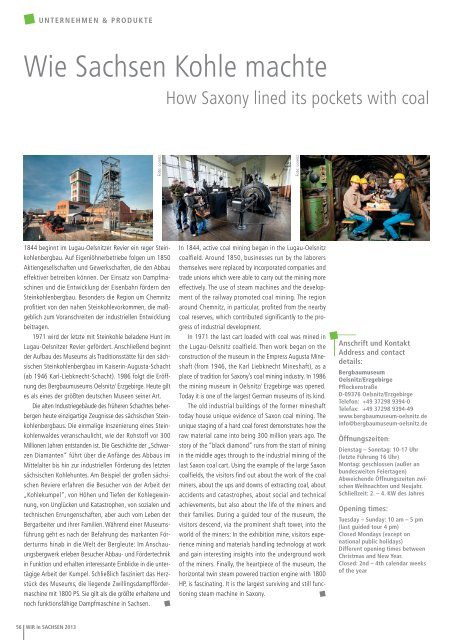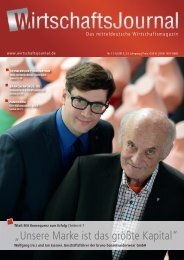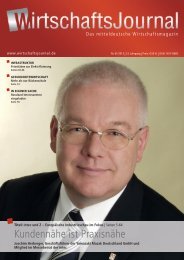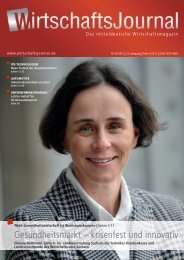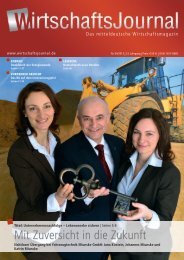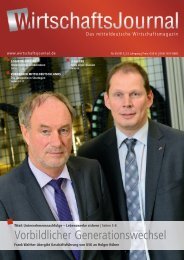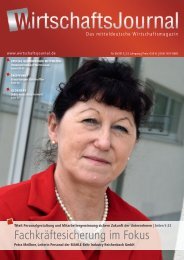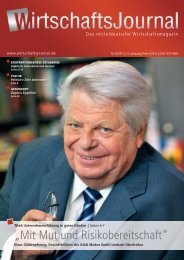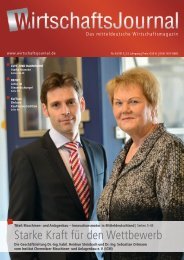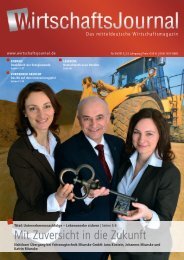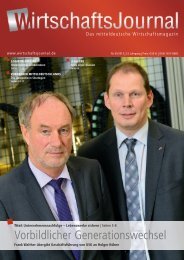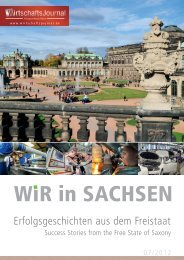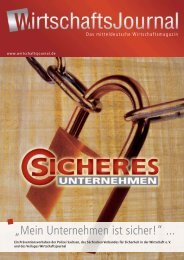Wir in Sachsen - Wirtschaftsjournal
Wir in Sachsen - Wirtschaftsjournal
Wir in Sachsen - Wirtschaftsjournal
Erfolgreiche ePaper selbst erstellen
Machen Sie aus Ihren PDF Publikationen ein blätterbares Flipbook mit unserer einzigartigen Google optimierten e-Paper Software.
U N T E R N E H M E N & P R O D U K T EWie <strong>Sachsen</strong> Kohle machteHow Saxony l<strong>in</strong>ed its pockets with coalFoto: LorenzFoto: Lorenz1844 beg<strong>in</strong>nt im Lugau-Oelsnitzer Revier e<strong>in</strong> reger Ste<strong>in</strong>kohlenbergbau.Auf Eigenlöhnerbetriebe folgen um 1850Aktiengesellschaften und Gewerkschaften, die den Abbaueffektiver betreiben können. Der E<strong>in</strong>satz von Dampfmasch<strong>in</strong>enund die Entwicklung der Eisenbahn fördern denSte<strong>in</strong>kohlenbergbau. Besonders die Region um Chemnitzprofitiert von den nahen Ste<strong>in</strong>kohlevorkommen, die maßgeblichzum Voranschreiten der <strong>in</strong>dustriellen Entwicklungbeitragen.1971 wird der letzte mit Ste<strong>in</strong>kohle beladene Hunt imLugau-Oelsnitzer Revier gefördert. Anschließend beg<strong>in</strong>ntder Aufbau des Museums als Traditionsstätte für den sächsischenSte<strong>in</strong>kohlenbergbau im Kaiser<strong>in</strong>-Augusta-Schacht(ab 1946 Karl-Liebknecht-Schacht). 1986 folgt die Eröffnungdes Bergbaumuseums Oelsnitz/ Erzgebirge. Heute giltes als e<strong>in</strong>es der größten deutschen Museen se<strong>in</strong>er Art.Die alten Industriegebäude des früheren Schachtes beherbergenheute e<strong>in</strong>zigartige Zeugnisse des sächsischen Ste<strong>in</strong>kohlenbergbaus.Die e<strong>in</strong>malige Inszenierung e<strong>in</strong>es Ste<strong>in</strong>kohlenwaldesveranschaulicht, wie der Rohstoff vor 300Millionen Jahren entstanden ist. Die Geschichte der „SchwarzenDiamanten“ führt über die Anfänge des Abbaus imMittelalter bis h<strong>in</strong> zur <strong>in</strong>dustriellen Förderung des letztensächsischen Kohlehuntes. Am Beispiel der großen sächsischenReviere erfahren die Besucher von der Arbeit der„Kohle kumpel“, von Höhen und Tiefen der Kohlegew<strong>in</strong>nung,von Unglücken und Katastrophen, von sozialen undtechnischen Errungenschaften, aber auch vom Leben derBergarbeiter und ihrer Familien. Während e<strong>in</strong>er Museumsführunggeht es nach der Befahrung des markanten Förderturmsh<strong>in</strong>ab <strong>in</strong> die Welt der Bergleute: Im Anschauungsbergwerkerleben Besucher Abbau- und Fördertechnik<strong>in</strong> Funktion und erhalten <strong>in</strong>teressante E<strong>in</strong>blicke <strong>in</strong> die untertägigeArbeit der Kumpel. Schließlich fasz<strong>in</strong>iert das Herzstückdes Museums, die liegende Zwill<strong>in</strong>gsdampffördermasch<strong>in</strong>emit 1800 PS. Sie gilt als die größte erhaltene undnoch funktionsfähige Dampfmasch<strong>in</strong>e <strong>in</strong> <strong>Sachsen</strong>.In 1844, active coal m<strong>in</strong><strong>in</strong>g began <strong>in</strong> the Lugau-Oelsnitzcoalfield. Around 1850, bus<strong>in</strong>esses run by the laborersthemselves were replaced by <strong>in</strong>corporated companies andtrade unions which were able to carry out the m<strong>in</strong><strong>in</strong>g moreeffectively. The use of steam mach<strong>in</strong>es and the developmentof the railway promoted coal m<strong>in</strong><strong>in</strong>g. The regionaround Chemnitz, <strong>in</strong> particular, profited from the nearbycoal reserves, which contributed significantly to the progressof <strong>in</strong>dustrial development.In 1971 the last cart loaded with coal was m<strong>in</strong>ed <strong>in</strong>the Lugau-Oelsnitz coalfield. Then work began on theconstruction of the museum <strong>in</strong> the Empress Augusta M<strong>in</strong>e -shaft (from 1946, the Karl Liebknecht M<strong>in</strong>eshaft), as aplace of tradition for Saxony’s coal m<strong>in</strong><strong>in</strong>g <strong>in</strong>dustry. In 1986the m<strong>in</strong><strong>in</strong>g museum <strong>in</strong> Oelsnitz/ Erzgebirge was opened.Today it is one of the largest German museums of its k<strong>in</strong>d.The old <strong>in</strong>dustrial build<strong>in</strong>gs of the former m<strong>in</strong>eshafttoday house unique evidence of Saxon coal m<strong>in</strong><strong>in</strong>g. Theunique stag<strong>in</strong>g of a hard coal forest demonstrates how theraw material came <strong>in</strong>to be<strong>in</strong>g 300 million years ago. Thestory of the “black diamond” runs from the start of m<strong>in</strong><strong>in</strong>g<strong>in</strong> the middle ages through to the <strong>in</strong>dustrial m<strong>in</strong><strong>in</strong>g of thelast Saxon coal cart. Us<strong>in</strong>g the example of the large Saxoncoalfields, the visitors f<strong>in</strong>d out about the work of the coalm<strong>in</strong>ers, about the ups and downs of extract<strong>in</strong>g coal, aboutaccidents and catastrophes, about social and technicalachievements, but also about the life of the m<strong>in</strong>ers andtheir families. Dur<strong>in</strong>g a guided tour of the museum, thevisitors descend, via the prom<strong>in</strong>ent shaft tower, <strong>in</strong>to theworld of the m<strong>in</strong>ers: In the exhibition m<strong>in</strong>e, visitors experiencem<strong>in</strong><strong>in</strong>g and materials handl<strong>in</strong>g technology at workand ga<strong>in</strong> <strong>in</strong>terest<strong>in</strong>g <strong>in</strong>sights <strong>in</strong>to the underground workof the m<strong>in</strong>ers. F<strong>in</strong>ally, the heartpiece of the museum, thehorizontal tw<strong>in</strong> steam powered traction eng<strong>in</strong>e with 1800HP, is fasc<strong>in</strong>at<strong>in</strong>g. It is the largest surviv<strong>in</strong>g and still function<strong>in</strong>gsteam mach<strong>in</strong>e <strong>in</strong> Saxony.Anschrift und KontaktAddress and contactdetails:BergbaumuseumOelsnitz/ErzgebirgePflockenstraßeD-09376 Oelsnitz/ErzgebirgeTelefon: +49 37298 9394-0Telefax: +49 37298 9394-49www.bergbaumuseum-oelsnitz.de<strong>in</strong>fo@bergbaumuseum-oelsnitz.deÖffnungszeiten:Dienstag – Sonntag: 10-17 Uhr(letzte Führung 16 Uhr)Montag: geschlossen (außer anbundesweiten Feiertagen)Abweichende Öffnungszeiten zwischenWeihnachten und Neujahr.Schließzeit: 2. – 4. KW des JahresOpen<strong>in</strong>g times:Tuesday – Sunday: 10 am – 5 pm(last guided tour 4 pm)Closed Mondays (except onnational public holidays)Different open<strong>in</strong>g times betweenChristmas and New Year.Closed: 2nd – 4th calendar weeksof the year56WIR <strong>in</strong> SACHSEN 2013


